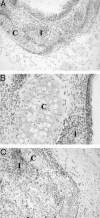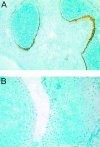Relapsing polychondritis, induced in mice with matrilin 1, is an antibody- and complement-dependent disease
- PMID: 14982849
- PMCID: PMC1614711
- DOI: 10.1016/S0002-9440(10)63183-5
Relapsing polychondritis, induced in mice with matrilin 1, is an antibody- and complement-dependent disease
Abstract
Relapsing polychondritis is an autoimmune disease that affects cartilage in the ear, nose, and respiratory tract. A pathogenic immune response has been proposed and antibodies to several cartilage proteins are detected in sera from these patients. To investigate the role of the humoral immune response in relapsing polychondritis, we used the matrilin-1-induced relapsing polychondritis model. Mice deficient of B cells (muMT) and mice congenic at the complement factor 5, were immunized with matrilin-1, a cartilage-specific protein mainly detected in the tracheal cartilage. To investigate the binding properties and tissue selection of matrilin-1-specific antibodies we produced matrilin-1-specific B-cell hybridomas. Although 83% of the micro MT heterozygous mice developed respiratory distress and erosive chondritis in the respiratory tract, none of the B-cell-deficient mice were susceptible to disease. In addition, we show that complement factor 5 is important for the induction of matrilin-1-induced relapsing polychondritis. Monoclonal matrilin-1-specific antibodies injected into neonatal mice bound specifically to cartilage of the respiratory tract and adult B-cell-deficient mice injected with the same antibodies developed erosive chondritis in the respiratory tract. We conclude that relapsing polychondritis can be mediated by a pathway involving tissue-specific antibodies and complement activation.
Figures






Similar articles
-
Critical role of the major histocompatibility complex and IL-10 in matrilin-1-induced relapsing polychondritis in mice.Arthritis Res Ther. 2004;6(5):R484-91. doi: 10.1186/ar1218. Epub 2004 Aug 12. Arthritis Res Ther. 2004. PMID: 15380048 Free PMC article.
-
A new animal model for relapsing polychondritis, induced by cartilage matrix protein (matrilin-1).J Clin Invest. 1999 Sep;104(5):589-98. doi: 10.1172/JCI5740. J Clin Invest. 1999. PMID: 10487773 Free PMC article.
-
The occurrence of autoantibodies to matrilin 1 reflects a tissue-specific response to cartilage of the respiratory tract in patients with relapsing polychondritis.Arthritis Rheum. 2001 Oct;44(10):2402-12. doi: 10.1002/1529-0131(200110)44:10<2402::aid-art405>3.0.co;2-l. Arthritis Rheum. 2001. PMID: 11665983
-
Cartilage-specific autoimmunity in animal models and clinical aspects in patients - focus on relapsing polychondritis.Arthritis Res. 2002;4(5):296-301. doi: 10.1186/ar425. Epub 2002 Jul 17. Arthritis Res. 2002. PMID: 12223103 Free PMC article. Review.
-
Relapsing polychondritis: prospective study of 23 patients and a review of the literature.Medicine (Baltimore). 1976 May;55(3):193-215. Medicine (Baltimore). 1976. PMID: 775252 Review.
Cited by
-
Critical role of the major histocompatibility complex and IL-10 in matrilin-1-induced relapsing polychondritis in mice.Arthritis Res Ther. 2004;6(5):R484-91. doi: 10.1186/ar1218. Epub 2004 Aug 12. Arthritis Res Ther. 2004. PMID: 15380048 Free PMC article.
-
Development and validation of diagnostic and activity-assessing models for relapsing polychondritis based on laboratory parameters.Front Immunol. 2023 Oct 3;14:1274677. doi: 10.3389/fimmu.2023.1274677. eCollection 2023. Front Immunol. 2023. PMID: 37854592 Free PMC article.
-
A case of localized tracheobronchial relapsing polychondritis with positive matrilin-1 staining.BMC Rheumatol. 2020 Jan 29;4:1. doi: 10.1186/s41927-019-0103-6. eCollection 2020. BMC Rheumatol. 2020. PMID: 32016169 Free PMC article.
-
Comparison between idiopathic and VEXAS-relapsing polychondritis: analysis of a French case series of 95 patients.RMD Open. 2022 Jul;8(2):e002255. doi: 10.1136/rmdopen-2022-002255. RMD Open. 2022. PMID: 35868738 Free PMC article.
-
Anti-citrullinated protein antibodies cause arthritis by cross-reactivity to joint cartilage.JCI Insight. 2017 Jul 6;2(13):e93688. doi: 10.1172/jci.insight.93688. eCollection 2017 Jul 6. JCI Insight. 2017. PMID: 28679953 Free PMC article.
References
-
- McAdam LP, O’Hanlan MA, Bluestone R, Pearson CM. Relapsing polychondritis: prospective study of 23 patients and a review of the literature. Medicine (Baltimore) 1976;55:193–215. - PubMed
-
- Foidart JM, Abe S, Martin GR, Zizic TM, Barnett EV, Lawley TJ, Katz SI. Antibodies to type II collagen in relapsing polychondritis. N Engl J Med. 1978;299:1203–1207. - PubMed
-
- Meyer O, Cyna J, Dryll A, Cywiner-Golenzer C, Wassef M, Ryckewaert A. Relapsing polychondritis—pathogenic role of anti-native collagen type II antibodies. A case report with immunological and pathological studies. J Rheumatol. 1981;8:820–824. - PubMed
-
- Yang CL, Brinckmann J, Rui HF, Vehring KH, Lehmann H, Kekow J, Wolff HH, Gross WL, Muller PK. Autoantibodies to cartilage collagens in relapsing polychondritis. Arch Dermatol Res. 1993;285:245–249. - PubMed
Publication types
MeSH terms
Substances
LinkOut - more resources
Full Text Sources
Molecular Biology Databases

